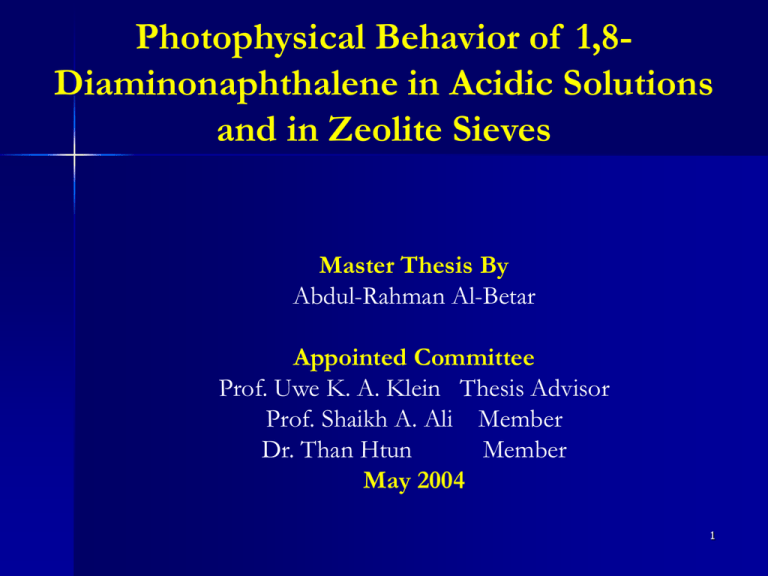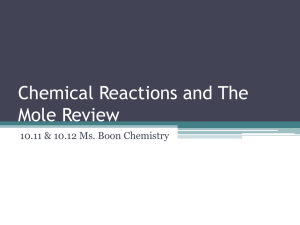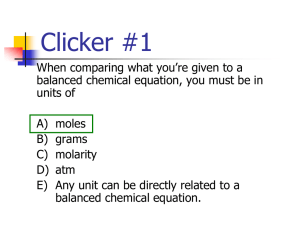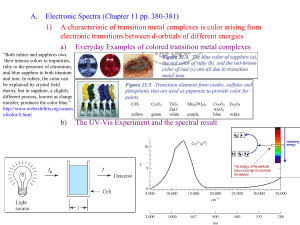Behavior of 1,8-Diaminonaphthalene
advertisement

Photophysical Behavior of 1,8Diaminonaphthalene in Acidic Solutions and in Zeolite Sieves Master Thesis By Abdul-Rahman Al-Betar Appointed Committee Prof. Uwe K. A. Klein Thesis Advisor Prof. Shaikh A. Ali Member Dr. Than Htun Member May 2004 1 Outline Introduction Aim of this study General kinetics scheme of 1,8-DAN Proposed kinetics scheme of 1,8-DAN 2 General Overview of Proton-Transfer 1950s Kinetics of Proton-transfer reactions became the subject of many studies Eigen Was the first to measure the fast recombination of H+ and OH- using relaxation method Forster and Weller Were the first to explain the difference between the ground and the excited states of the dissociation constants 3 Short Pulse It becomes possible to directly measure protontransfer of excited molecules 4-H-1-NS and 1-AN Have been studied by means of laser-induced picosecond spectroscopy 1,8-DAN Is the subject of this research 4 OH NH 2 SO34-hydroxy-1-naphalenesulphonate 1-Aminonaphthalene NH 2 NH 2 1,8-diaminonaphthalene 5 Aim of this Study Paul et al. have studied 1,8-DAN in sulphuric acid solutions. However, there is no complete analysis of the overall reaction scheme. To set up the complete behavior scheme of 1,8-DAN in the ground and excited state with varying acidity. Photochemical characterizations of zeolite, based on fluorescence properties. Which is a new insight for industry using spectroscopic measurements 6 General Scheme of 1,8-DAN Proton Transfer 1,8-DAN has two amino groups that could be protonated NH2 NH3 NH2 + NH2 pK1 + +H Abs NH2 +H Flu Abs NH2 NH3 + +H NH3 pK1 pK2 Flu Abs NH2 NH3 + H+ NH3 Flu NH3 pK2 7 Absorption Spectra of 1,8-DAN by Paul et al. neutral mono-cation di-cation Abs. 1 0.8 0.6 0.4 0.2 0 220 270 320 370 nm 8 Absorption Spectra Of The Three Forms 1,8-DAN At 8.0*10-5 M Neutral pH 2 pH -1 8000 Extinction Coefficient ( e) 7000 6000 5000 4000 3000 2000 1000 0 250 270 290 310 330 350 370 390 Wavelength/nm 9 Only One Transition, Earlier Suggested by Paul et al. for DANH+ Absorption spectra disprove this structure H H H H + N N H 10 Two Different Transitions For DANH+ NH2 330nm H H NH2 NH2 280nm 280nm NH2 330nm 11 Dissociation Constants NH2 NH3 NH2 + NH2 pK1 + +H Abs NH2 +H Flu Abs NH2 NH3 + +H NH3 pK1 pK2 Flu Abs NH2 NH3 + H+ NH3 Flu NH3 pK2 12 Dissociation Constants in the Ground State pH = pKa + log [A- ] / [HA] When [A-] equals [HA] pH = pKa pKa1 = 4.0 0.5 D Abs 0.4 0.3 0.2 0.1 0 0 1 2 3 4 5 6 7 8 9 10 pH 13 Dissociation Constants in the Ground State pKa2 = -0.1 0.25 D Abs. 0.2 0.15 0.1 0.05 0 -1.5 -1 -0.5 0 0.5 1 1.5 pH 14 Dissociation Constants in the Excited State pK* was determined by Forster-Cycle pKa* = pKa - h C NA (l -1 HA - l-1A- ) / 2.303 R T Where l is the wavelength taken at the 0-0 transition between absorption and emission spectra 15 Absorption and fluorescence spectra of the neutral of 1,8-DAN Fluo. Neutral Irel Abs. Neutral 250 300 350 400 450 500 550 600 wavelength/nm 16 Acidity constants in the ground and first excited states Equilibrium pKa Paul et al. DANH+ ↔ DAN + H+ 4.2 DANH22+ ↔ DANH+ + H+ -0.1 pKa* Our work Paul et al. 4.0 ---0.1 -6.5 Our work -9.7 -10.7 Where pKa* is theoretical values obtained from Forster-Cycle 17 Fluorescence Spectra NH2 NH3 NH2 + NH2 pK1 + +H Abs NH2 +H Flu Abs NH2 NH3 + +H NH3 pK1 pK2 Flu Abs NH2 NH3 + H+ NH3 Flu NH3 pK2 18 Fluorescence Spectra of 1,8-DAN by Paul et al. neutral mono-cation di-cation 10 Irel 8 6 4 2 0 300 400 nm 500 600 19 Fluorescence Spectra Of The Three Forms 1,8DAN Neutral pH-1 pH2 10 8 6 Irel Emission of the neutral and pH 2, show the same emission peak at lEX= 340 nm 4 2 0 300 350 400 450 500 550 600 wavelength/nm 20 Fluorescence Spectra Of The Three Forms 1,8DAN Emission of the neutral and pH 2, at lEX = 300 nm Neutral pH -1 10 8 Irel Red shift due to solvent relaxation pH 2 6 4 2 0 300 350 400 450 500 550 600 Wavelength/nm 21 Solvent Relaxation Process Due to changes of dipole moment on excitation, shifting of energy levels occur with lower energy gap Which cause a red shift in the fluorescence spectrum S1 S0 22 Quenching Constant, kq proton-induced fluorescence quenching has been observed for mono-cation form prior to the formation of di-cation The quencher for the neutral form emission is [H+] Whereas, the quencher for the protonated form emission is [H2O]free i.e. the proton acceptor 23 Neutral Form Quencher 0.01 M 0.5 M 0.05 M 0.7 M 0.1 M 0.9 M 0.2 M 1.0 M 8 Irel 6 4 2 0 300 350 400 450 500 550 600 w av elength/nm 24 Intermediate Emission 4M 3M 2M 1M 5M 6M 3 Irel 2 1 0 300 350 400 450 500 550 600 w av elength/nm 25 Protonated Form Quencher 11.8 M 10 M 9M 8M 8 Irel 6 4 2 0 300 350 400 450 500 550 600 wavelength/nm 26 Quenching Constant, kq 1 h 1 h0 k qt 0 h0 [H ] Plotting 1/h Vs. [H+], gives slope = kq t0 /h0 kq = 1.26 x 109 M-1s-1 With good agreement to the finding by SternVolmer plot using lifetime ( kq = 1.29 x 109 M-1s-1) Which is within 2% error 27 Stern-Volmer plot t0 1 k qt 0 [ H ] t Plotting t0/t Vs. [H+], gives slope = kq t0 kq = 1.29 x 109 M-1S-1 t 0 /t y = 9.9249x + 0.6813 12 10 8 6 4 2 0 0 0.2 0.4 0.6 0.8 1 [H+] 28 Proposed Scheme for Proton transfer reactions of 1,8-DAN NH 2 NH 2 Diabatic process in the excited state NH3 NH3 NH3 NH2 + H+ kd k'q [H2O] + kq[H ] kf ' kf Iabs Iabs Iabs NH3 NH3 NH3 NH2 NH2 NH2 pk1 + H+ 4.0 + +H pk2 -0.1 29 Quenching Constant, kq’ h0 1 55.5k 'q t acidg [ H 2O ] free h Plotting h0/h Vs. g[H2O]free k’q = 3.12 * 108 M-1s-1 y = 9612.5x 5 - 6889.7x 4 + 1688.9x 3 - 132.93x 2 - 6.2152x + 0.9989 0.8 g [H2O]free g[H2O] Vs. g[HClO4], was taken from earlier work by El-Rayyes et al. and then was applied to our concentration in this work. 1 0.6 0.4 0.2 0 0 0.05 0.1 0.15 0.2 0.25 g[HClO4] 30 Fluorescence Decay Measurements The decay of the neutral and the mono-cation form have very similar decays, Both are single-exponential and nicely fit the equation: I(t) = I0 e-t/t Whereas the decay for the di-cation form shows bi-exponential decay and nicely fit the equation: I(t) = A1 e-t/t1 + A2 e-t/t2 31 Fluorescence Decay Profile Of The Three Forms Of 1,8-DAN Neutral ph 2 ph -1.1 12000 10000 No. Count Decay emission of the neutral and pH 2 are similar 8000 6000 4000 2000 0 0 5 10 time/ns 15 20 25 32 Lifetime Measurements t t1 /ns 1,8-DAN Paul et al. Neutral t2 /ns Our work Paul et al. Our work 1.6 7.7 --- Mono-cation 7.4 8.3 --- Di-cation --- 1.6 --- 22.2 33 Energy Surface for the Mono-cation Form S1 + H2 O E 427 KJ/mol 412 KJ/mol 363 KJ/mol S0 0.25KJ/ mol 9.9KJ/mol H NH2 NH2 H NH2 NH2 NH 2 NH 2 + H+ 280nm 330nm 330nm 280nm 330nm 330nm 34 Energy Surface for the Di-cation Form No [H2O]free + [H2O]free + NH 3 H NH 3 NH2 NH2 + H+ 280nm 280nm 280nm 330nm 35 Zeolite Y Sieves Zeolite Y has a major channel of 12 member Oxygen ring . Its pours diameters d1 = 12 Å d2 = 7.4 Å Y-zeolite 36 Calcination Process Three forms of zeolite Y were used: NaY, HY 34% and HY96% NaY can be changed to HY of different concentrations by ion exchange with NH4NO3 NH4NO3 + NaY NH4Y 500 °C HY + NH3(g) 37 Protonation Process NH2 NH2 H H O O Si Al Si Si NH2 H H O Si O NH2 O Si O Al Si O Si Si O 38 Why 1,8-DAN inside Zeolite Sieves ? To do acidity characterization of solid acids e.g. Zeolite Y Acidity characterization can be done by: 1. Temperature-programmed desorption (TPD) Qualitative 2. Calorimetric methods Qualitative 3. Fourier transformation infrared (FTIR) Qualitative 4. Laser-induced spectroscopy (LI) Introduced by El-Rayyes et al. Quantitative 39 Emission Spectra of DAN /Zeolite Y DAN/NaY shows the neutral band of 1,8-DAN. However, under higher energy excitation it shows the protonated band even there is no proton Some interesting effects with Na+ ion i.e. the lone pairs interact with Na+ to give the higher energy band 40 Emission Spectra of NaY Ex 340 nm NaY Ex 300 nm 8 Irel 6 4 2 0 300 350 400 450 500 550 600 nm 41 Emission Spectra of DAN /Zeolite Y DAN/HY 34% shows both neural band and the protonated band of 1,8-DAN. DAN/HY 96% shows both the neural band and the protonated band of 1,8-DAN. However, under higher energy excitation it gives low energy band. Which need further studies 42 Emission Spectra of HY 34% Irel HY 34% Ex 300nm 5 4 3 2 1 0 300 350 400 450 500 550 nm 43 Conclusion 1,8-DAN shows a Diabatic Reaction Process i.e. the reaction of the excited neutral form with H+ does not lead to the excited mono-protonated form, rather it goes to the ground state. There are three different forms of 1,8-DAN in the ground state. Whereas, there are only two forms in the excited state. 44 Proposed Scheme of 1,8-DAN NH 2 NH 2 NH3 NH3 NH3 NH2 + H+ kd k'q [H2O] + kq[H ] kf ' kf Iabs Iabs Iabs NH3 NH3 NH3 NH2 NH2 NH2 pk1 + H+ 4.0 + +H pk2 -0.1 45 Conclusion The Mono-cation form has two transitions band, rather than one transition as believed before, which is supported by absorption spectra. The Di-cation form has a bi-exponential decay which suggest the existence of a new form X. i.e. an adduct between the solvent molecules and the fluorophore molecules as shown for 1-AN. 46 Conclusion The excited state reactions is very sensitive to the presence or absence of water molecules and protons, which makes 1,8DAN possibly a good indicator for zeolite acidity. i.e. 1,8-DAN may be used as a probe molecule to assess zeolite acidity. 47 Acknowledgement All praise be to Allah for his limitless help and guidance. Peace pleasing of Allah be upon his prophet Mohammed. To my advisor Prof. Uwe Klein To other members: Prof. A. Ali and Dr. Than Htun To helpful discussion: Dr. El-Rayyes To helpful consultation: Dr. Fettouhi To technicians help: M. Arab and Mr. Mazhar To graduate advisor, chemistry chairman and dean of science college To all faculty, staff and students 48 Thank You All 49 NH 2 NH 2 50 NH 2 NH 2 51






